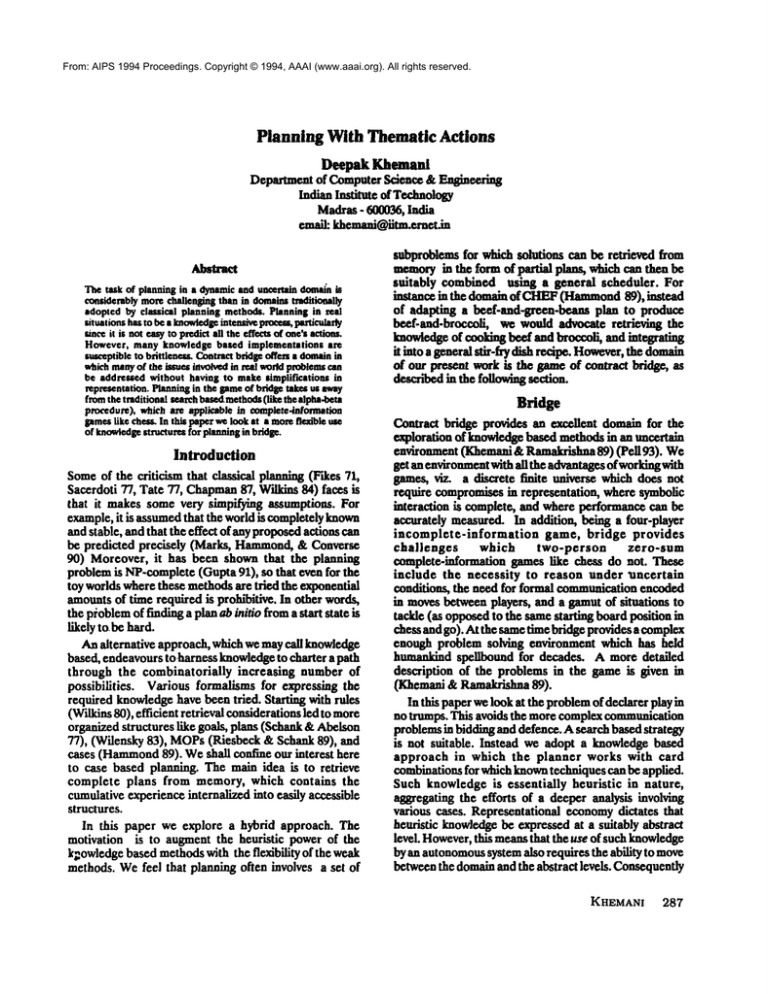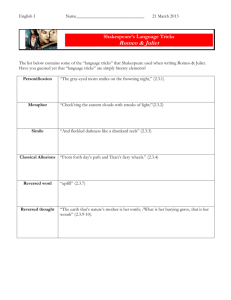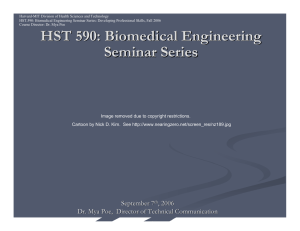
From: AIPS 1994 Proceedings. Copyright © 1994, AAAI (www.aaai.org). All rights reserved.
Planning With ThematicActions
Deepak Khemani
Department of ComputerScience & ~-~eeri~
Indian Institute of Tecimology
Madras- 600036,India
emall: khemani@iitm.ernet.in
Abstract
Thetask of planning in a dynamicand uncertain domainis
considerablymorechallengingthan in domainstraditionally
adopted by classical planning methods. Planning in real
situations has to be 8 knowiedp
intm ptoceu,particudarly
sinceit is noteasyto predictall theeffectsof one’sactions.
However, manyknowledge bated implementations are
susceptible to brittleness. Contractbridge oReaa domainin
whichmany
of the issuesinvolvedin real worldproblemscan
be addreued without having to make simplifications in
rapretentation,planningin the lameof bridp takesus away
fromthe traditiona! searchhasedmethods
(like the alpha-beta
procedure), whichare app]icable in oomplatednformation
gamesUk¢chess. In this paperwelook at a moreflexible use
of knowledge
structures for planningin bridge.
Introduction
Someof the criticism that classical plannin~(F~es71,
Sacerdoti 77, Tate 77, Chapman
87, Wilklng84) faces is
that it makessomevery simpifying assumptions. For
example,it is assumedthat the worldis completelyknown
andstable, andthat the effect of anyproposed
actionsca,,
be predicted precisely (Marks, Hammond,
& Converse
90) Moreover, it has been shownthat the planning
problemis NP-complete
(Gupta91), so that evenfor the
toy worldswherethese methodsare tried the exponential
amountsof time required is prohibitive. In other words,
the pioblemof findinga planab initio froma start state is
likely to be hard.
Analternative approach,whichwemaycall knowledge
based, endeavoursto harnessknowledge
to charter a path
through the combinatorially increasing number of
possibilities. Various formalismsfor expressing the
required knowledge
havebeentried. Starting with rules
(Wilkins80), efficient retrieval considerations
led to more
organizedstructures like goals, plans (Schank&Abelson
77), (Wilensky83), MOPs
(Riesbeck& Schank89),
cases (Hammond
89). Weshall confine our interest here
to case based planning. Themain idea is to retrieve
complete plans from memory, which contains the
cumulativeexperienceinternalized into easily accessible
structures.
In this paper we explore a hybrid approach. The
motivation is to augmentthe heuristic powerof the
k~.owledge
basedmethodswith the flexibility of the weak
methods.Wefeel that planning often involves a set of
subproblemsfor whichsolutions can be retrieved from
memory
in the form of partial plan~ whichcan then be
suitably combined using a general scheduler. For
instance in the domainof CHEF
(I’l~mmond 89), instead
of adapting a beef-and-green-beans plan to produce
beef-and-broccoli, we wouldadvocate retrieving the
knowledgeof cookingbeef and broemli, and integratln~
it into a generalstir-fry dtsh recipe. However,
the domain
of our present workis the gameof contract bridge, as
describedin the followingsection.
Bridge
Contractbridge provides an excellent domainfor the
exploration of knowledge
based methodsin an uncertain
environment(]Chemaui& Ramakrishua89) (Pen 93).
get an environment
with all the advantagesofworldn~with
games,viz. a discrete finite universe whichdoes not
require compromises
in representation, wheresymbolic
interaction is complete,and whereperformancecan be
accurately measured.In addition, being a four-player
incomplete-information game, bridge provides
challenges
which two-person
zero-sum
complete-informationgameslike chess do not. These
include the necessity to reason under ~ancertain
conditions, the need for formal communication
encoded
in movesbetweenplayers, and a gamutof situations to
tackle (as opposedto the samestartin~ boardposition in
chessandgo). At the sametime bridge providesa complex
enough problem solving environment which has held
humankindspellbound for decades. A more detailed
description of the problemsin the gameis given in
(Khemani& Ramakrishua89).
In this paperwelook at the problemof declarer playin
no trumps. This avoids the morecomplexcommunication
problemsin biddingand defence.Asearch basedstrategy
is not suitable. Instead we adopt a knowledgebased
approach in which the planner works with card
combinationsfor whichknowntechniquescan be applied.
Such knowledgeis essentially heuristic in nature,
aggregatingthe efforts of a deeper analysis involving
various cases. Representationaleconomydictates that
heuristic knowledge
be expressedat a suitably abstract
level. However,
this meansthat the use of such knowledge
by an autonomous
systemalso requires the ability to move
betweenthe domainandthe abstract levels. Consequently
KHEMANI
287
From: AIPS 1994 Proceedings. Copyright © 1994, AAAI (www.aaai.org). All rights reserved.
the knowledge structures proposed in this paper arc
composedof three diverse generic (Chandrasekaran 86)
components;recognition, analysis, and instantiation.
The granularity of the knowledgestructures is such that
they apply only to a combination of a few cards, rather
than the play of the entire hand. That is, the heuristic
knowledge,which is in the form of ’strong’ structures,
suggests partial plans. The play of most handscan be seen
as a combination of such knownphys. Selecting the
different relevant structures, and comblnln~their actions
into a coherent plan is the task of a scheduler, whichhas
a flavour of a ’weak’ method.
p|annln~; as described in the sections that follow, is
accomplishedas a two stage process - the activation of
various knowledgestructures suggesting possible partial
plan%followed by the assemblin~of a feasible plan using
some of them.
Retrieving
Partial
Plans
It can be reasonably claimed that a bridge hand once
played will not be repeated. Nevertheless, one finds that
humanperformance improves with learnln~ The kind of
knowledgethat players seem to employis a repertoire of
standard plays, for examplefinesses and squeezes, plans
for which are reused in different combinations in new
situations. Wecall the chnnk of knowledgewhich captures
the themebehind the actions of a standard play a thematic
act (TA). A TAhas knowledgeof patterns to look for
the raw data, knowledgeof movecombinations (a partial
plan), and knowledgeof the overall effect of the moves
(which we call meta-semantic knowledge). Weexplore
the the nature of such thematic knowledgein the context
of contract bridge.
Functional Abstraction
In any interesting enoughdomainthe numberof different
cases would be too manyto put in memoryindividually.
Instead the goal should be to try and extract general
principles which are applicable in manycases. Consider,
for example,the concept of a ’fmesse’ in bridge. It can be
illustrated by the following case, whereall the cards are
from the same suit, and "?" represents an unknowncard.
North : A Q
West : ??
East : ??
South : 32
(1)
South plays the 3. Let us say West plays the 8. If North
plays the Q, then the play is said to be a finesse. If the K
is in the West hand then the North-South side makes an
extra trick with the Q. If on the other handthe K is in the
East hand, the fmessefails and East can winthe trick.
The important feature in the above play is the
combination of Ace &Queenwhich forms a ’tenace’ over
the West hand. Straight awaywe can see that the South
cards are insignificant, and could have been any of the
288
POSTERS
small cards. Also we can see that the North hand could
havehad AK J, and one could have still finessed the Jack.
Whatis more, if the A K Q and J had already been played,
then a combinationof 10 &8 could have formed a teuace
over East’s 9. Sofunctiona//y a tenace can be defined as
follows,
North : RC1 RC3
South: x
(2)
whichessentially says that if there is a rank-class-10RC1)
card along with a rank-class-3 (RC3)card, and there
small card in the other hand then one can/dan to take a
finesse a~aingt the opponent’s RC2card. The rank-class
is different from the rank; in the ~ that it equates cards
of tOUehln~ranks; held by a side. For e~mmple,
if both the
Aceand the ]gln~ belongto the same side then both are
of rank-class 1, whereasthe rank of K is 2. In other words,
since both the Aceand the gln~ arc held by the sameside,
the Kingcould also considered to be a winner.
Thus the tenace is a functional abstraction which
characterizes the situation whena finesse can be played.
Eachcard is viewedfunctionally by its role, which may
vary in different situations, rather than by its identifier,
which is constant. In addition one is looking for
combinations which can be exploited. This is quite
different from the accepted mcanln~of abstraction, for
example in ABSTRIPS(Sacerdoti 74), where the
emphasisis only on ignoring unnecessarydetail.
The Level el" Knowledge
The knowledgecaptured in a TAis aimed at its use. It
does not provide for a situation-action-effect analysis that
could provide an explanation why the recommended
actions are useful. Consequentlyit cannot also cater to
extra-thematic situations. Consider, for example, the
following TA. The hands are,
North: K9x
South: AJ x x x
(3)
Weneed four tricks from this combination, and can
afford to lose one (but not two). The standard play, which
the TArecommends
in thi~ situation, is to play the A first,
and then a small card towards the K-9, intendln~ to play
the 9. However,if Westdoes not follow suit, win with the
gin~. and play the 9 towards the Jack. It maybe observed
that this play is somewhat
counter intuitive as it tends to
disrupt the A-J tenace that exists.
The knowledge contained in the TA cannot provide
explanations as to whythis play is best. That requires a
deeper analysis whichdeals with cases, and is along the
following lines. There is a danger when one of the
opponents holds O-10-x-x. In such a situation the above
play insures agaln.ct losing two tricks. If West holds
Q-10-x-xhe is forced to play one of the Q or 10 lest North
wins with the 9. Andthen the 9 and the Jack betweenthem
From: AIPS 1994 Proceedings. Copyright © 1994, AAAI (www.aaai.org). All rights reserved.
that the play
will restrict Westto winnlno only Onetrick with the other
card. If East holds the O-lO-x-xthen Westwill showout
on the second round. North wins, and now playing
towards the Jack ensures that East c~ only win with the
Ouccn. The intuitive play, on the other hand, with thi~
card combination,is to first winthe King, and then finesse
the Jack. This play is best for Winnin~
five tricks, but when
West has Q-10-x-x it loses two tricks. The recommended
play for four tricks also guards against this eventuality.
However,the ability to do the abovenslysis has no effect
on the success of the TAin that situation.
There can be extra-thematic situations where the
standard advice has to be ignored. One such situation
arises whenwhenone is willing to aker one’s risk-gain
equation. Thus, it mayhappen, in the aboveexample, that
in a larger context (eg. a tournament)one is willing to risk
losing twotricks for the small gain of aa extra trick (when
only four are required). However, such reasonin~ is
beyond
thescopeof this work.
Planning WithThe TAs
The goal in bridge is to arrive at a plan to makea certain
numberof tricks. The dealt cards dealt define the starting
position. The opponents’ cards are not known. However
someinformation maybe available from the bidding, and
more accrues as play proceeds. Weesamlne the role of
TAsin forming the plan.
The basic strategy used in the plannlno process is
Means Ends Analysis (MEA)(Newel163). This applies
easily to the bridge problemas the goalofmakln~acertain
numberof tricks can be split into conjuncts of develop’mg
tricks in different suits. There arc, hov~’-~r, overall
constraints imposeddue to sharing of common
resource~s.
For e~mmple,if we need to develop three tricks, and there
e~st two suits that can provide two each, it maystill not
be possible to develop both due to ’tempo’ restrictions.
So, the TAsmerely suggest partial plans to reduce a part
or whole of the difference, and it is left to an overall
scheduler to assemble the best combination.
The TAprovides the knowledgeto tackle a given card
combination.It is not necessary, however,that a suit can
be optimally played in isolation. For e~ample, in the
following card combination,
North : A O J
South : 643
(4)
the recommended
play is to finesse twice. This requires
that twice the play be started from the South position.
Eachtime the lead shifts to the Northhand, since the trick
~
is wonthere. Someother suit needs to provide an ’entry
into the South hand to fmesse again. The partial plan is
not complete in itself, and mayneed to be meshedwith
other partial plans. In this waythe plays for different suits
need to be interleaved and woventogether. Notice also
for the above combination
hierarchically
composed
usingthefinesse.
can be
Constraints
Each suit has some potential
for developing a certain
number of tricks with.some probability. For e~,,,ple
combination(3) can be played for 4 tricks with greater
insurancethan for 5 tricksy_, andit can be playedfor 3 tricks
with assured results. However, there are different
conditions required by each of the plays. The 3 trickplay
requires available/eewuyand tempoto be at least 2~ These
terms are defined below. The 4 trick play requires them
to he at least 1, whilethe 5 trick play allowsneither leeway
nor tempo.
The selection of different TAcombinationsis dictated
by someoverall comtraints. Constraints are of two types.
Oneis the maximum
nnmherof tricks that the planner can
afford to lose. For example,if you have contracted for 13
tricks,andneed
only4 from
thecombination
(3), youstill
cannot ~l~ the 4-tllck play because it allows for losing
one trick to the. opponants. That is, the/eetmyrequired is
one, but available zero. Therefore, even though the play
suggestsitself, the schedulercannot select it.
A related constraint is that oftempo.This is determined
by howclose the opponents are to settino up tricks for
themselves. It is measuredinterms of thenwnber
of6mes
the planner can lose tricks to the opponents before they
are in a position to defeat the contract. It is the job of the
scheduler to pick up a combination of the TAswhich is
within the overall leewayand tempoconstraints.
The Scheduler
The task of pl~nnin~is to combineTAsfor different suit
combinationsto achieve the overall goal of tricks. In doing
so one has to be careful that the different partial plans can
he combinedtogether to form a feasible line of action.
For example,if combination(4) is replicated in all suits,
North : A Q J, AQJ, A Q J,A Q J 10
South : 643, 643, 643, 6432
(5)
then not morethan one finesse could be pepsi_hie, though
the TAs would create partial plans for 9 of them!
However,if someof the suits were interchanged,
North : A Q J,643, A Q J, 6432
South : 643, A Q J, 643, A Q J 10
(6)
then all 9 finesses could be effected, possibly winningall
13 tricks.
Hence by doing a meta-semantic analysis of the plays
offered by different suits a suitable plan can be arrived at.
The TAsthemselves are tuned to the best suit play, i.e.,
one that has highest probability of success. The task now
is to combinesomeof theminto forming a plan. In doing
so one maydiscover that a TAcannot be directly applied,
and one mayhave to look for an alternate play which can
KHEMANI 289
From: AIPS 1994 Proceedings. Copyright © 1994, AAAI (www.aaai.org). All rights reserved.
fit into the plan. The plan generated will have a certain
probability of sucee-~sthat is determi-edby the probability
of the assumptions,madeell route, being true.
Co~nn~ Stro~ xad Weak Methods
Theoverall planninL, activity canbethus seen as following.
Thetask is to order the play of twosets of thirteen cards.
A partial order is imposedby a TAon the play of a suit.
However,the partial plan for a suit maybe dependenton
the existence of a suitable partial plan for another suit.
This happens for example in combination 4, where two
entries in one handare neededfor if the partial plan is to
be incorporated. This me-ghinoof differant partial plane is
done by the scheduler, whosejob is to essentially merge
the partial plans for the four suits.
It can be seen that there are two distinct aspects to the
task of planning. The first, whichinvolves retrieving the
TAs, is more knowledgeintensive. Each partial plan is
retrieved complete with its ownordering (Berlin 85).
the other hand the scheduler which assembles plans is
essentially the embodimentof a weakmethod. F’tgure 1
schematicallyillustrates the formationof partial plans and
assemblln~ a total plan with some of them. Such an
architecture is imperative if plannin~is to be done in any
complex domain. An autonomousagent in such a domain
will have to cater to manygoals which crop lip as it
ftmcLious, p)annln~; therefore, can no longer be viewed
as problem solving for a well defined goal, but is an
ongoingprocess. A basic requirement, in such a domain,
is the ability to incorporate partial solutions in one’s
activity. This will aLso enable opportunistic pJannin~
(Hayes-Roth & Hayes-Roth 79) specifically
while
executing plant (Birnbaum85).
Implementation
Wehave implemented a program for declarer play in
bridge. The input to the program is the dedarefs hand
(South), the dummy(North), and the opeuln~ lead
by West. Currently the program plays only no trump
oontracts.
The program begins by abstracting the relevant
patterns out of the cards. It counts its tricks, and
computesthe goal (i.e. the numberof tricks that have to
be generated), and the comtraint& leeway and tempo.
The program then looks for card combinations that it
’lmows’to tadde effeaively. This information is provided
by the corresponding TAand the pattern also serves to
/ndeg the TA. The planner then constructs partial plans
using the procedural knowledge contained in the TA.
The current implementation generates one partial plan
for each suit and passes it on to the scheduler. If this
cannot fit into the overall plan, then the program
backtracks and tries another. The ordering of the moves
fromthe partial planl iS donein a heuristic mannerby the
scheduler. Thusthe right play in the case referred to in
(Berlin 85)isfound directly because of the heuristics
employed,rather than by a deeper analysis of interaction
of subgoals. Whileassembllnoa plan, the scheduler picks
movesfrom the partial pla.~ using a few heuristics. For
example,combination(4) requires that the suit be played
fromthe South hand, and it is the job of the scheduler to
incorporate the play whenthe opportunity presents itself.
Duringplay, if any assumptionsare violated then control
is passed back to the planner. This also happenswhenan
unexpected trick comesup. A more detailed description
of the program is given in (Ramaelhandran & Khemam
92).
I................
II
_]
I
I[................
l
El
ANNOTATION
The larger problem contains a set of smaller
problems for which (partial) solutions are
known.
A Thematic Planner looks at subproblems and
the TAs suggest partial plans. Numbersbelow
showtheir position in the flnai plan.
A general purpose scheduler looks at va6ous
thematic actions and assemblers together a
coherentplan of actions whichmeshtogether.
F’ig
290 POST~.~S
1 Two Stage Pmnn;ng --
A Schematic Flowchart
From: AIPS 1994 Proceedings. Copyright © 1994, AAAI (www.aaai.org). All rights reserved.
Results
NORTH-DUMMY
6AQf~t$
Thetrace left by the program
as it plansandplaystwo
brandsis.included
in theappendix.
Thetrace
coustitutes
of can’ :d messagesprinted by the various sections when
they execute. The input to the programare the North and
South hands. For our convenience the East West hands
havealso beenincludedin the printout.
In Hand
1 the spadesuit is ~fied as the sourceof
tricks. Thefeatureof usinga delayed
finesseto solvethe
commmdcationproblem has been encoded as a separate
TA. In Hand2 the assumed 3-2 break in spades does not
materlnli,¢, and the pregramis forced to replan. Knowing
that the spadefinesse will fail, it phn~to finesse in hearts.
In different run whenthe East-Westspade and heart suits
were interehJn~ed, the. program d/d prefer the spade
finesse knowingit will succeed.
Coneluding Remarks
In this paper we have looked at a two stage lnechanigmfor
planning, using contract bridge as the do~’4n. In the first
stagepartial plansare.suggested
byknowledge
structures
called thematic acts (TAs). In the second stage, a
scheduler combinesthe actions suggested by the TAsinto
a coherent plan. This mayoften require that actions of
different TAsbe interleaved. The scheduler is basically an
embodimentof a weak method, but one which operates
within the order imposedby the first stage of thematic
planning. In our implementation the strategy of
means-ends-analyslshas been adopted, as it is well suited
to the domain
of planningin bridge.
The results of our implementation have been very
encouraging, as can be witnessed in the examplesshown.
Wefeel that such a schemeof planning is particularly
attractive when planning in a complex domain where
(partial) plans for newer goals have to be incorporated
into the larger plans of an agent whomaybe continuously
interacting with the world.
Appendix
Traces Of TheProgram
This appendix contain~ the traces left by the programas
it plans and plays some hands. The trace contsing the
complete hand, followed by the trace, followed by the
record of play. Even in cases where the system replans
after someplay, the or~snlzation of text remainsthe same.
[Text in squarebrackets are commentsby the author. ]
F.~ample 1
CONTRACT = 3 NOTRUMP
The planningphase... Have6 top tricks .. Need3 tricks
more ... Tempoavailable 4 If Spades break 3 -2 we get 3
extra tricks losing 2 .. first glance over playinglow to low
due to lack of entries .. plan workable... Haveplannedfor
9J7
@84
6’1"65
WEST
6 KJ9
9098
@Q96
Openin~
EAST
6T7
9T632
@’]P52
lead-
K @
6J972
SOUTH
682
qeag.~
Example1
o,~Jr/3
6aK4
5 tricksin Spades,
2 tricks;w I-lear~
1 tricks
Diamondsand 2 tricks in Clubs.
Examininglead ... Lookslike a honour sequence.
The play ... A" indicates that the corresponding player
had the lead
S.NO
I.
2.
3.
4.
$.
6.
7.
8.
9.
10.
11.
12.
13.
WEST
¯ K*
@3"
6 9
88
AJ
6 K
¥ 8
@6
qF 9
¯ Q
@9
¯ Q
8 O
NORTH
¯ 4
65
6 3
86
A Q
& A*
6 6"
4b 5"
A 4*
V 7"
VJ
@8
8 T
BAST
¯ 2
6J
A T
8*2
&7
V2
qP 3
qP 6
qP T
8 7
@5
$ T
8 9
SOUTH
@3
6A
& 8"
6K
& 2"
W4
qP 5
@7
41,J
qP A
qFK*
¯ A*
8 4*
WON.BY
Wat
South
East
South
North
North
North
North
North
South
South
South
West
Tricks made = 10 Tricks contracted = 9
Example2
CONTRACT -- 7 NOTRUMP
The planning phase ... Have11 top tricks .. Need 2
tricks more... Tempoavailable 0 If Spades break 3-2 we
get I extra tricks losing 0 If Hearts break 6 -1 we get 2
extra tricks losing 2 .. can’t afford that If Diamonds
break
4-1 wegetI extra triclm losing0 .. first glance over Have
plannedfor 4 tricks in Spades,1 tricks in Hearts, 5 tricks
in Diamondsand 3 tricks in Clubs.
F.~am;nin~lead ... Looksliketop of a sequence
After trick 3 Plan aborted because of ExpectationFailure
Newplan being generated...
Have8 top tricks .. Need2 tricks more... Tempo
available
0 If Hearts break 6 -1 we get 2 extra tricks losing 2 ..
can’t afford that If Diamondsbreak 4 -1 we get I extra
KHEMANI
291
From: AIPS 1994 Proceedings. Copyright © 1994, AAAI (www.aaai.org). All rights reserved.
Chapman, D. 1987. Planning for Conjunctive Goals,
Artificial Intelligence, ~ 32. pg. 333.
WEST
Openln~lead6J975
JI
qPK3
@7
&T7652
FAST
64
qPJ6542
@I’965
&943
SOUTH
601’~
~7
Example 2
. AK~
~AK8
tricks losing 0 .. first glanceover[Notethat it doesnot loot
for spades as it knowsthat the break is not fm,ourable]
Tcnace over East found in Spades F’messe not pow’ble
as opponent has shown out Tenace over West found in
Hearts Have planned for 1 [more] tricks in Spades, 2
tricks in Hearts, 5 tricks in Diamondsand 2 tricks in
Clubs.
The play ... A * indicates that the corresponding player
had the lead
S.NO WEST NORTH ~ SOUTH WON-BY
1.
6 J*
6 Q
63 6 8
North
& A*
6 4 &6
2.
65
North
67
6 K*
64
68
North
3.
6
9
6
9
South
4,
6 2*
6 0
6
2
W
9
V
2
6
A*
South
5.
6.
6 5
V8
¯ $ 6 K*
South
7.
~Q
V4
V7"
North
93
8.
VK
~A"
W$ 6T
North
9.
¯ 7
¯ J*
¯ 6
@4
North
10.
&6
@2"
¯ 9
@A
South
It.
6 7
¯ 3
¯ T ¯ K* South
63
12.
6 T
9 6
@Q* South
6 J
¯ T
VJ
South
13.
¯ 8"
Tricks made -- 13 Tricks contracted = 13
********,t,**************************,t,*********,
References
Berlin, D.L.S. 1985. SPAN:Integrated Problem Solving
Tactics. In Proceedings IJCAI-85. pg 1047.
Birnbaum, L. I985. A Short Note on Opportunistic
Planning and Memoryin Arguments. In Proceedings
UCAI-85.pg 281.
Chandrasekaran,
B. 1986. Generic Tasks in
Knowledge-Based Reasoning: High-Level Building
Blocks for Expert SystemDesign. IEEEExpert, voi. 1. pg
23.
292
POSTERS
Fikes, R., and Nilsson, N. 1971. STRIPS: A New
Approach to the Application of Theorem Proving to
ProblemSolvi~ Am’tidalIntelligence, t¢~l. 2. pg. 189.
Gupta, N., and Dana~S.N. 1991. ComplexityResults for
Blocks-World plann|n~
Ill
PI’~ AAAI91. pg 629.
Hammond,K. 1989. Case-based Planning: Viewing
P/ann/rig
asa Memo,’y
Task,Perspectives
inArtificial
Intelligence,
Academic
Press,Bcsto~
MA.
Hayes-Roth, B., and I-layes-Roth, F. 1979. A Cognitive
Model of Planning, ~/ve Saence, ~ 3. pg 275.
Khemani D., and ]~tmakl~hna R.S. 1989. Bridge: A
Benchmark for KnowledgeBased plannlng, CC-AI,
Communicationand Cognition, t,~ ~ No. 2/3. Pig 137.
Marks M., HammondK.J., and Converse, T. 1988.
plnnln~ in an Open World: A Pluralistic Approach. In
~edln~ of Workshop on Case-Based Reasoning.
Newell, A., and Simon, H.A. Eds. 1963. GPS: A Program
that Simulates Htwnan Thought, in : Computers and
Thought, Feigenbaum, E.A., and Feldman, J.
Mc~3raw-Hill, NewYork.
Barney, Pell. 1993. Pragmatic Reasoning in Bridge,
Technical Report No. 299, Computer Laboratory,
University of Cambridge.
Ramachandran, R., and Klgmani, D. 1992. Plal~nln~
Declarer Play in Bridge, Tech. Report IrrM-CSE-92.02,
Dept. of CS&E,liT Madras.
Riesbeck, C., and Schank, R. 1989. Inside Case-based
Reason/rig, Lawrence Erlbaum Associates, Hillsdale,
NewJersey.
Sacerdoti, E. 1974. plannin.~ in a Hierarchyof Abstraction
Spaces,Am’ficialIntelligence, I,ol. 5, pg115.
Sacerdoti, E. 1977. A Structure for Plans and Behavior,
Elsevier, North Holland.
Schank;R.C., and Abelson,R. 1977. Soipts, Plans, Goals,
and Understanding, Lawrence Eribaum Associates,
Hillsdale, NewJersey.
Tare, A. 1977. Generating Project Networks. In
Proceedings IJCAI-77, Cambridge, Massachusetts, pg.
888.
Wilkins, D.E. 1980. Using Patterns and plan~ in Chess,
Artificial Intelligence,vol. 14. pg. 165.
Wilkins, D.E. 1984. Domain-Independent Planning:
Representation
and Plan Generation, Artificial
Intelligence,~ol. 22. pg. 269.






